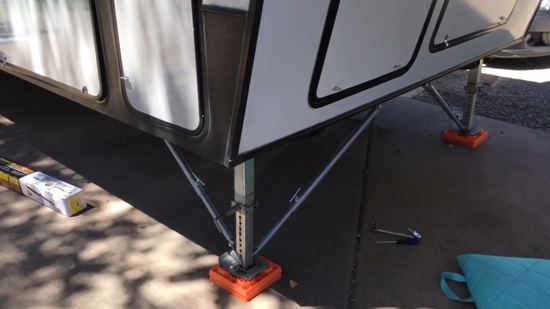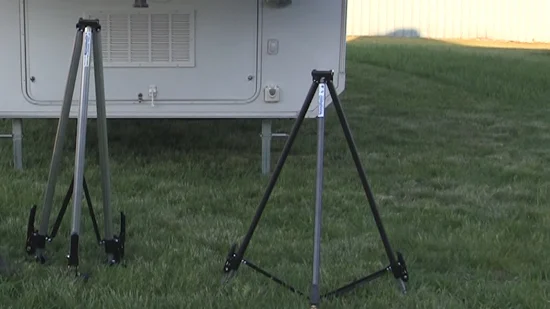Fifth-wheel RV owners are aware that their vehicles are subject to a fair amount of rocking when parked. This is especially true if there’s any kind of wind blowing or if people are walking inside the RV.
Many people are tempted to purchase a fifth wheel stabilizer, but they may be wondering if they’re actually effective. Do fifth wheel stabilizers work? If you are considering making a purchase, you need to know the answer to this question.
This will assist you in determining whether a fifth wheel stabilizer is worth your money. We’re going to get into this topic in more detail, so keep reading to find out the actual answer.
Do Fifth Wheel Stabilizers Work? Discover the Truth

There is no doubt that fifth-wheel stabilizers work well. Fifth-wheel stabilizers are designed to keep your RV safe and level while you are parked.
They work by distributing the weight of the RV evenly across the stabilizer jacks, preventing the RV from shaking.
This is especially important if you are parked on an uneven surface, as it will prevent your RV from tipping over.
Fifth-wheel stabilizers can also help to protect your RV from damage caused by high winds or other severe weather conditions. Investing in a good set of fifth-wheel stabilizers makes you feel rocking-free while you are parked.
Factors That Keep in Mind for Getting the Best Output from Fifth Wheel Stabilizers
Now that we know that fifth-wheel stabilizers work, it’s important to understand how to get the best results. There are a few different factors that you need to keep in mind when using fifth-wheel stabilizers. These include:
1. Choosing the Right Size: Fifth-wheel stabilizers come in various sizes, so it’s essential to select the one that best fits your needs. For example, if you have a large fifth-wheel trailer, you’ll need a larger stabilizer than someone with a smaller trailer.
It’s important to consider the weight of your travel trailer when choosing a stabilizer. A heavier trailer will require a more robust stabilizer, so be sure to take this into account when making your selection.
2. Use a Quality Fifth-Wheel Stabilizer: Many people do not realize that the market has different grades of fifth wheel stabilizers.
Some are made with cheaper materials and will not last as long or perform as well as a higher quality fifth wheel stabilizer. To achieve the best results, it is essential to invest in a high-quality fifth wheel stabilizer.
Your fifth wheel stabilizer will last longer and provide better stability for your trailer if it is of a higher quality. The maintenance and upkeep of an appropriately-constructed fifth wheel stabilizer will be easier.
3. Install the Fifth-Wheel Stabilizer Properly: When installing a fifth-wheel stabilizer, it is important to follow the instructions carefully.
If you do not install the stabilizer properly, it will not work correctly. Check the nut and bolt tightness frequently to ensure the RV stabilizer is installed correctly.
4. Placing the Stabilizers Correctly: It is also important to make sure that they are placed correctly. This means that they should be positioned evenly on both sides of the trailer and that they should be at the same level.
Without the correct positioning, they will not provide the necessary stability. Another thing to keep in mind is the weight distribution of the trailer.
If the trailer is not balanced correctly, then it will be more difficult for the stabilizers to do their job. It is important to ensure the ground is level before setting up the fifth wheel stabilizers.
5. Checking the Condition of the Stabilizers Regularly: Maintaining your fifth wheel stabilizers is important to ensure that you get the best performance and longevity from them.
Regularly monitoring the stabilizers’ condition will allow you to identify any potential problems early on and take steps to rectify them.
In particular, you should check for signs of wear and tear, such as cracks or chipped paint. If you notice any damage, addressing it as soon as possible is important to prevent further deterioration.
You should also ensure that the stabilizers are properly lubricated and adjusted. This will help to ensure that they operate smoothly and efficiently.
These simple steps allow you to keep your fifth wheel stabilizers in top condition and get the best possible performance from them.
Is a 5th Wheel Stabilizer Necessary?

Although fifth-wheel stabilizers are not a must-have accessory for all RVers, they can be a very helpful addition for those who often camp in areas with uneven terrain.
If you find that your trailer rocks back and forth or side to side when you are trying to sleep, a fifth-wheel stabilizer can help to reduce this movement and provide a more comfortable sleeping experience.
Fifth-wheel stabilizers are useful for keeping your trailer level and preventing it from sinking in areas with soft ground, such as sand or gravel.
Generally, a fifth-wheel stabilizer can provide peace of mind on the road and enhance your camping experience. You might feel rocky and unbalanced whenever you move around inside a 5th wheel RV without a stabilizer.
This can be extremely jarring and may even cause items inside your RV to fall over. This is why having a fifth-wheel stabilizer will help you avoid these potential problems and make your RVing experience more enjoyable.
Different Types of 5th Wheel Stabilizers
Understanding the different types of fifth-wheel stabilizers is important as it will help you decide which type best suits your needs. Here is a short overview of fifth-wheel stabilizer types that are available:
1. 5th Wheel King Pin Tripod Stabilizer: This is the most popular type of fifth wheel stabilizer and provides maximum stability. It consists of three legs extending from the trailer’s center and resting on the ground.
A hitch cup is located at the top of the stabilizer and fits over the trailer’s kingpin. Most of these stabilizers are adjustable, so you can adjust them to fit your trailer perfectly.
Each leg has a foot that provides additional stability and prevents the leg from sinking into soft ground. A chain connects each leg to the other, ensuring that they remain in place.
2. 5th Wheel Stabilizer Jack: An RV stabilizer jack is attached to the trailer frame to stabilize a fifth-wheel trailer. Using this device, you can maintain the level and stability of your truck camper.
It is placed at the corners of the trailer and extends from the ground up to the underside of the trailer. There are typically two jacks per side, although some trailers may have one jack per side.
The jacks are operated manually, usually with a crank handle. Some models may also have an electric motor that can be used to raise and lower the jacks. The jacks can be adjusted to level the trailer, and the frame helps to distribute the weight evenly.
3. X-Brace Stabilizer: The X-brace stabilizer is designed to provide extra strength and stability to fifth-wheel trailers. This stabilizer consists of two metal bars attached to the RV’s frame.
Each bar is perpendicular to the other and crossed in the middle. It looks like an X-shape, hence the name. The fifth wheel stabilizers work by providing a stable base for the trailer.
By keeping the trailer in a fixed position, this stabilizer minimizes the chances of your fifth-wheel trailer swaying or tipping. The stabilizers also help to evenly distribute the weight of the trailer, which reduces the amount of stress on the tires.
4. Scissor Jack Stabilizer: This is another type of fifth-wheel stabilizer that provides increased stability. By cranking the handle, it can be operated from within the trailer’s frame.
The stabilizer consists of two pairs of opposed arms that are connected at the top by a crossbar. It is possible to adjust the arms according to the needs of the fifth wheel.
When the RV is parked, the stabilizer can be used to level the fifth wheel, preventing it from rocking back and forth.
5. Hitch Mount Stabilizer: It consists of a metal frame with two legs that extend to the ground. The stabilizer is adjustable so that it can be positioned to provide support for the fifth wheel as needed.
The hitch is shaped like a “V”, and the point of the “V” is connected to the fifth wheel hitch. This stabilizer helps distribute the trailer’s weight evenly and prevents the fifth wheel from tipping.
Stabilizer legs are equipped with foot pads that increase stability. This way, the legs will be prevented from sinking into soft ground. A strap is also connected between the legs from one side to the other to assist with the stability of the stabilizer.
6. Slide Out Stabilizer: A slide-out stabilizer provides additional stability to a fifth-wheel trailer. The device fits into the trailer’s frame and is operated by a crank handle.
It is a single pipe-type stabilizer that has a wide base foot pad. On top, there is a U-shaped bracket attached to the RV’s slide-out frame. The foot pad of the stabilizer provides excellent stability, while the U-shaped bracket secures the RV’s slide-out frame.
Can a 5th Wheel Tip Over When Parked?
It is a common misconception that 5th wheels cannot tip over when they are properly parked. This is not always the case. If a 5th wheel is not properly secured, it can be vulnerable to tipping in high winds or on uneven ground.
Fifth wheels are often heavier than other types of trailers, making them more susceptible to tipping if they are not properly balanced.
For these reasons, it is important to take care when parking the 5th wheel and to make sure that it is firmly secured before leaving it unattended. Also, use 5th wheel stabilizers to give extra support.
Do I Need to Place Blocks Under Fifth Wheel Stabilizer Jacks?
The answer to this question depends on several factors, including the type of RV you have, the terrain you’ll be camping on, and your personal preferences. In general, it’s always a good idea to place blocks under your stabilizer jacks, just to be safe.
Not only will this help to keep your RV from tipping over, but it will also make it easier to level out your rig. Also, if you’re going to be parked on uneven ground, blocks will help to keep your RV level.
What Materials Are Used In the Manufacture of 5th Wheel Stabilizers?
There are a variety of different materials that can be used in the manufacture of fifth wheel stabilizers, but the most common are steel and aluminum.
Steel is typically used for its strength and durability, while aluminum is chosen for its lightweight and corrosion resistance. In most cases, the choice of material will be dictated by the application’s specific needs.
For example, if the stabilizer is going to be used in an environment exposed to salt water, aluminum would be the better choice due to its superior corrosion resistance.
Use Fifth Wheel Stabilizers, Get a Smooth Experience
If you have a fifth-wheel RV, investing in a good quality fifth-wheel stabilizer can be beneficial. As you can see, fifth-wheel stabilizers effectively prevent your RV from rocking back and forth or tipping over.
Since there are several types of fifth-wheel stabilizers available, be sure to choose one best suited for your RV and camping needs. Do not forget to place blocks under your fifth wheel stabilizer jacks for extra support and protection.
Always make sure that your RV is securely parked before leaving it unattended. After all, your safety is the most important thing.
Leave a Reply